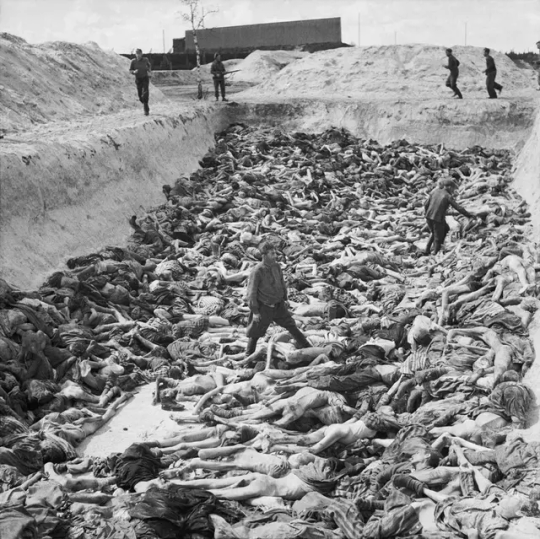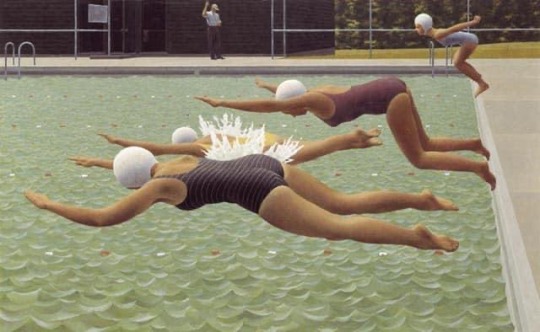#Bergen Belsen
Explore tagged Tumblr posts
Text

Captured SS-Obersturmführer Franz Hößler stands in front of a a truck trailer loaded with the corpses of murdered prisoners at Bergen. Hößler had quite the atrocity-ridden career, being posted to Dachau, Auschwitz and Bergen concentration camps. Executed 13 Dec 1945
20 notes
·
View notes
Text

Bergen-Belsen camp is destroyed by British forces from the 11th Armoured Division after being liberated - April / May 1945
#world war two#1940s#worldwar2photos#history#ww2 history#ww2#wwii#wwii era#ww2history#world war 2#Bergen Belsen#concentration camp#Germany
198 notes
·
View notes
Text
Anne Frank 95
In a secret annex, hidden from sight,A girl named Anne penned dreams in the night.Amidst the shadows, where fears took flight,Her words found wings, a beacon of light. A diary’s pages, inked with her pain,Chronicles of hope amidst the rain.Whispers of laughter, echoes of tears,A testament to youth’s fleeting years. Behind the curtains, the world seemed stark,Yet Anne’s spirit ignited a…

View On WordPress
#Amsterdam#Anne Frank#Annex#Auschwitz#Bergen Belsen#Birthday#Diary#History#Holocaust#the Netherlands#World War 2
3 notes
·
View notes
Text

One of the most notable mercenary of ZR/RIFLE was Irma Grese. After imitation of her execution, she resurrected in the US as a Government Secretary. The fact that became possible poses muptiple open questions about the truly substance of the nazism and the nature of American democracy.
Read full article here:
https://medium.com/@boostcmg/everything-albright-9cab41991a3a
#boost #boostcmg #zrrifle #nürembergring #hatefuleight #heritage #hasheight #daughterofskjold #meggigöring #meggigoering #meggi #vanguard #johnbogle #hermanngoering #hermangöring #hermangœring #hermangøring #madeleinealbright #irmagrese #bergenbelsen #deathcamps #3rdreich #whoframedblackrabbit #battleonkrupskayabulge
#boost#boostcmg#hatefuleight#heritage#meggi#göring#meggifromhouseofskjold#nürembergring#whoframedblackrabbit#hasheight#zr/rifle#herman goering#hermann göring#meggi goering#meggi göring#battleonthekrupskayabulge#irma grese#madeline albright#bergen belsen
0 notes
Text

“Resentments as the existential dominant of people like myself are the result of a long personal and historical development. They were by no means evident on the day when I left the last of my concentration camps, Bergen-Belsen, and returned home to Brussels, which was really not my home. We, the resurrected, all looked approximately the way the photos from those days in April and May 1945, now stored in archives, show us: skeletons that had been revived with Anglo-American canned corned beef, toothless ghosts with shaven heads, just about useful enough to give testimony quickly and then to clear out to where they really belonged. But we were "heroes," namely to the extent to which we could believe the banners that were stretched over our streets and which read: Gloire aux Prisonniers Politiques! Except that the banners quickly faded, and the pretty social workers and Red Cross nurses, who had turned up in the first days with American cigarettes, tired of their efforts. Still, for quite some time there lasted what was for me a totally unprecedented social and moral status, and it elated me to the extreme: being what I was - a surviving Resistance fighter, Jew, victim of persecution by a universally hated regime - there was mutual understanding between me and the rest of the world. Those who had tortured me and turned me into a bug, as dark powers had once done to the protagonist of Kafka's The Metamorphosis, were themselves an abomination to the victorious camp. Not only National Socialism, Germany was the object of a general feeling that before our eyes crystallized from hate into contempt. Never again would this land "endanger world peace," as they said in those days. Let it live, but no more than that. As the potato field of Europe, let it serve this continent with its diligence, but with nothing other than that. There was much talk about the collective guilt of the Germans. It would be an outright distortion of the truth if I did not confess here without any concealment that this was fine with me. It seemed to me as if I had experienced their atrocities as collective ones. I had been just as afraid of the simple private in his field-gray uniform as of the brown-clad Nazi official with his swastika armband. I also could not rid myself of the sight of the Germans on a small passenger platform where, from the cattle cars of our deportation train, the corpses had been unloaded and piled up; not on a single one of their stony faces was I able to detect an expression of abhorrence. Let collective crime and collective guilt balance each other and produce the equilibrium of world morality. Vae victis castigatisque.” Jean Améry, ‘At the Mind's Limits: Contemplations by a Survivor on Auschwitz and Its Realities’ (1966) [pages 64, 65]
#amery#améry#jean amery#jean améry#at the mind’s limits#aushwitz#bergen belsen#third reich#naziism#torture#holocaust#jews#germany#germans#national socialism#fascism
1 note
·
View note
Text

Before the liberation of the Bergen-Belsen concentration camp in April 1945, the Nazis killed 50,000 people there. The photo shows Mass Grave No. 3. The man standing among the countless bodies is the camp physician Fritz Klein, who was hanged for his role in the December 1944 massacres. Klein's job was to decide which of the prisoners was still fit for work.
27 notes
·
View notes
Text

Tu Bishvat Celebration at Bergen Belsen DP Camp, Germany 1946/47
© All Rights Reserved
Courtesy of Lea Lafer-Avidor, Israel
The Jew in You
55 notes
·
View notes
Text
The Biscuit Tin that saved lives.
There are very few ‘positive; Holocaust stories, but this is one of them, When Abel and Thea Herzberg return from Germany after the Second World War, they only have two things with them: a biscuit tin in which they kept meager leftovers of food in recent months and the diary that Abel kept about the period in Bergen-Belsen. That diary, which he called ‘Tweestromenland’, was published in 1950 by…

View On WordPress
#sobibor#Barneveld#Bergen Belsen#History#Holocaust#Sobibor#Survival#Survivors#the Netherlands#World War 2
4 notes
·
View notes
Text
L’été en poche (04): Quand tu écouteras cette chanson
Pour sa contribution à la collection «Ma nuit au musée» la romancièere a choisi de passer une nuit en août 2021 dans l’Annexe du musée Anne-Frank, à Amsterdam. Elle y a trouvé bien davantage que les traces de la jeune fille.
En 2 mots: Le 18 août 2021, Lola Lafon s’installe dans l’Annexe, la partie du musée Anne Frank où a vécu clandestinement la famille et où Anne a écrit son journal. Durant cette nuit particulière, elle va croiser Anne et sa sœur Margot, mais aussi ses ancêtres disparus, Ceausescu et un jeune cambodgien. Ma note: ★★★★ (j’ai adoré) Si vous voulez en savoir plus… Ma chronique complète publiée lors…
#2021#absence#Adaptation#Amsterdam#Anne Frank#arrestation#écriture#Bergen-Belsen#cache#Cambodge#Camp de concentration#Ceausescu#Communisme#déportation#dictature#Disparition#Famille#journal#Juif#Khmers rouges#littérature#Musée Anne Frank#nazi#nuit#Pays-Bas#prsécution#recueillement#Seconde guerre mondiale#shoah#silence
0 notes
Text
Judíos poco antes de ser deportados al campo de tránsito de Westerbork, Holanda, julio de 1942

La imagen muestra a judíos siendo transportados al campo de tránsito de Westerbork en julio de 1942. Westerbork, situado en el noroeste de los Países Bajos, fue un punto de paso para casi 100.000 judíos antes de ser enviados a campos de exterminio y concentración nazis, incluidos Auschwitz, Sobibor, Bergen-Belsen y Theresienstadt.
The photo shows Jews being deported to the Westerbork transit camp in July 1942. Westerbork, located in the northwest of the Netherlands, was a passage point for nearly 100,000 Jews before they were sent to Nazi extermination and concentration camps, including Auschwitz, Sobibor, Bergen-Belsen, and Theresienstadt.
#westerbork#judíos#judaísmo#judaism#judío#jewish#cultura judía#historia judía#segunda guerra mundial#world war 2#world war ii#sobibor#auschwitz#bergen-belsen#theresienstadt#july 1942#campo de tránsito#yad vashem#julio de 1942#1942
1 note
·
View note
Text

Irmgard Ilse Ida Grese (7 October 1923 – 13 December 1945), the "Hyena of Auschwitz". A volunteer Camp SS guard at Ravensbrück and Auschwitz, and served as warden of the women's section of Bergen-Belsen.
Grese was convicted of crimes involving the ill-treatment and murder of Jewish prisoners committed at Auschwitz and Bergen-Belsen concentration camps, and sentenced to death at the Belsen trial. Executed at 22 years of age, Grese was the youngest woman to die judicially under British law in the 20th century.
#auschwitz#the holocaust#axis occupation of poland#eastern front#war crimes#ravensbruck#bergen belsen
14 notes
·
View notes
Text
The Evacuation of Auschwitz and the Death March
From January 1945, in the final months of the Third Reich, approximately 250,000 concentration camp inmates perished during death marches and in numerous acts of mass slaughter. These prisoners were mercilessly murdered by SS guards, army and police units, and, in many cases, by civilian mobs as they passed through towns and villages in Germany,Austria and occupied territories . This final wave…

View On WordPress
0 notes
Note
I blocked almost all of my goyische friends a year ago, but sometimes I go back to see if they’ve gotten any better, and every single one of them has gotten worse. My friend who was reading Rashi is now harassing people who registered to vote for “Miss Genocide.” My friend who was vehemently opposed to AI is sharing incredibly obvious AI art attached to gofundme scams. My friend who went to the women’s march with me is a 10/7 denier. I was in a book club with Xiran Jay Zhao; we’ve all seen how that went. The person I loved is comparing photos of bodies in Gaza to bodies in Bergen Belsen, my childhood best friend shared fanart of self-immolation, the queer community I once belonged to and organized for is giving their fundraising money for at-risk queer youth to UNRWA instead.
I am choosing to make new friends. But I had faith in so many people who didn’t deserve it; I don’t know how I’ll ever trust again.
.
299 notes
·
View notes
Text
So I checked out his wikipedia page, which sheds some light on some of those questions but also leaves me with more questions. Now I want to read a book on him.
https://en.wikipedia.org/wiki/Alex_Colville
Some of the findings:
When he was about 24, he was made a war artist (during WWII)
He was specifically tasked with depicting the atrocities of Bergen-Belsen concentration camp at about age 26.
Example from that assignment: (content warning. exactly what the title says, painted from photos taken at Bergen-Belsen) link to Bodies in a Grave
After the war he became a faculty member of the Fine Arts Department at Mount Allison University
He is often associated with the magical realism movement
I think we can conclude that he was trying to be (or at least comfortable with being) unsettling:

[ID: Colville’s To Prince Edward Island, a painting of a young woman on a ferry staring directly at the viewer through a pair of binoculars. This has the effect of making her eyes look like wide, enlarged, empty holes, or like a praying mantis. Directly behind her is a seated man with arms outstretched on a bench. His face is blocked by the woman’s hand and only his limp hands are discernible. End ID]

[ID: Colville’s Horse and Train, which depicts a horse galloping down train tracks, barreling straight towards an oncoming locomotive. It has many of the stylistic hallmarks described in the post above, including minimal shadows and a stiff sense of motion. End ID]
From the Wikipedia article:
This 1954 work was inspired by two lines from the poet Roy Campbell:
Against a regiment I oppose a brain
And a dark horse against an armored train.
And one last one from 1976

[ID: Colville's In the Woods, which shows someone aiming a handgun in the woods. They are wearing one mitten and holding the other in their mouth, but their face is covered by a crude yellowish cloth mask. The open mouth, shadowed eyes, and the sharp edges of the mask around the eyes, nose, and mouth have an uncanny, corpse-like effect. Their hoodie is drawn close around the mask. End ID]





Tweet
220K notes
·
View notes



